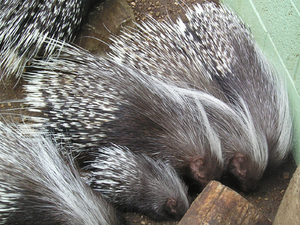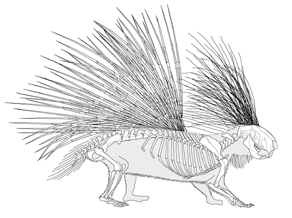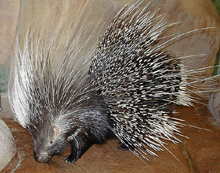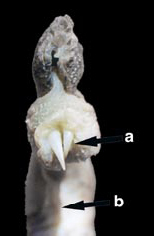
|
| ©Marwell Zoological Park |
* Hystrix is traditionally divided into three 'subgenera': Thecurus, of Borneo, Sumatra and the Philippines (three species), Acanthion of China and SE Asia (two species), and the crested porcupines proper, Hystrix (three species). So, within the genus Hystrix, we're mostly looking here at members of the subgenus Hystrix.
The three crested porcupines (H. cristata, H. indica and H. africaeaustralis) are big rodents, weighing up to 30 kg, and inhabit Africa, Asia Minor, the Arabian Peninsula, and at least some of southern and south-eastern Europe (whether they're native to Europe has been controversial: some people think they were introduced). They're herbivorous but have been reported to sometimes eat small animals and to occasionally nibble at carrion. The need to gnaw at big, hard objects means that crested porcupines have a very visible impact on their environment. They collect bones (carrying them back to the burrows they live in) and chew on them, and it's reasonably well known that porcupine-gnawed bones from Makapansgat in South Africa were misidentified by Raymond Dart as weapons created by australopithecines (these supposed tools formed the basis for Dart's 'osteodontokeratic culture'). Porcupines also gnaw on hard vegetation, which is fair enough, but more remarkable is the fact that they also chew on stones and even at rock exposures (Gow 1992). While out hiking in 1991, C. E. Gow and his family were surprised to discover obvious porcupine gnaw marks on every exposed surface of a 500-m-long band of 50-cm-thick siltstone. Amazing.

|
| ©www.archaeozoo.org |
All porcupines are pretty good at escaping from captivity: due, I suppose, to good burrowing abilities and the ability to gnaw their way through barriers. Consequently, individuals have been at large in the British countryside on occasion. In 1969 two Himalayan or Hodgson's porcupines H. brachyura hodgsoni escaped from Pine Valley Wildlife Park near Okehampton on Dartmoor: they bred, and by 1973 a population of about 12 had apparently destroyed 15% of a spruce plantation (H. brachyura hodgsoni is a member of Acanthion and thus not a crested porcupine like Hystrix cristata). They were in the habit of regularly raiding local crop fields and a terrier died after a confrontation with one of the animals. Field guides written during the 1970s suggested that the population might get established and hence become a major agricultural pest (Burton 1980). However, by 1979 several of the porcupines had been captured and others had been killed, so the colony was thought to have died out. However... sightings of mysterious spiky creatures 'much larger than a hedgehog' were still continuing in the region in 1991... The latest word on the Dartmoor porcupines is that they were successfully eliminated by ADAS, the Agricultural Development and Advisory Service (Baker 1990) [image above borrowed from Archeozoo's guide to mammal skeletons].

|
| ©Unknown |
When irritated or frightened, crested porcupines vibrate their tails, making a rattling noise [image above shows H. cristata with erected quills]. What's neat is that the quills that make this noise are not simple, straight quills like those seen elsewhere on the body: they are instead very special structures and have in fact been described as the most specialised hair structures in the animal kingdom (Hanney 1975). When the porcupine is young, the tips of some of its tail quills break off, leaving weird, hollow-tipped structures that are shaped like champagne flutes: the 'stem' of the structure is the bit that inserts into the tail. These bizarre quills are apparently used by fishermen as floats in some parts of the world. Special noise-making tail quills are present in other porcupines (the brush-tailed Atherus species) but are completely different, consisting of elongate air-filled cells connected by thin segments. Rodent quills are actually pretty diverse and unusual in their details, with those of some groups having grooves or scales on their surfaces.

|
| ©Atalar & Ceribas |
Like turtles, pigs and waterfowl, crested porcupines are yet another group of animals that have surprising, recently discovered novelty in their genitalia. In H. cristata, cornified papillae cover the glans and corpus of the penis (as they do in mice and domestic cats). Rather more peculiar however are the two small spikes present just under and behind the glans (Atalar & Ceribasi 2006). When the penis is erected, these objects are extruded from the body of the organ [image above showing underside of penis from Atalar & Ceribasi 2006. 'a' marks the spikes]. During intromission, it is assumed that they somehow attach to part of the vagina, but exactly what goes on here is unknown so far as I know. I don't think this reflects any sort of penisocentric bias: it's simply easier to extrude and meddle with a dead or anaesthetised penis than it is to peer deep into the recesses of a vagina. Insert here hilarious quip about personal experience. Anyway... so, now you know: porcupines even have spines on their penises.
Dammit: yet again, what was meant to be a 'picture of the day' just kept growing and growing and growing.
Refs --
Atalar, O. & Ceribasi, A. O. 2006. The morphology of the penis in porcupine (Hystrix cristata). Veterinarni Medicina 51, 66-70.
Baker, S. J. 1990. Escaped exotic mammals in Britain. Mammal Review 20, 75-96.
Burton, J. A. 1980. Wild Animals. Collins, London.
Gow, C. E. 1992. Gnawing of rock outcrop by porcupines. South African Journal of Geology 95, 74-75.
Hanney, P. W. 1977. Rodents: Their Lives and Habits. David & Charles, Newton Abbot.



Reader Comments
to our Newsletter